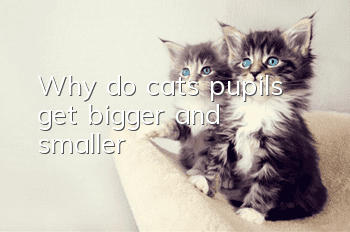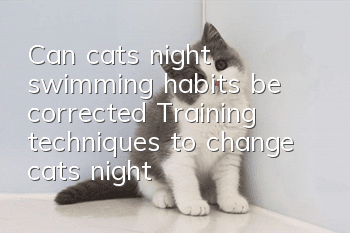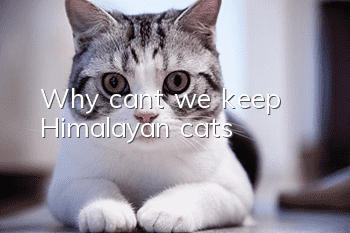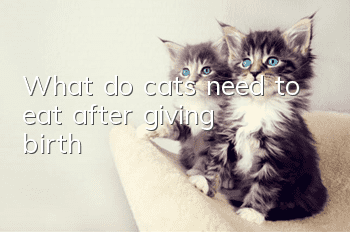Why do cats’ pupils get bigger and smaller?

This is because cats automatically adjust the size of their pupils according to the intensity of light to adapt to different light conditions.
When the ambient light is sufficient, a cat's pupils will shrink into slits, so that objects can be seen clearly in relatively little light.
When the light is low, a cat's pupils will expand into a circle to absorb more light.
Therefore, cats' pupil size changes to adapt to visual needs under different light conditions.
Tip:
When a cat’s mood changes, its pupils will change accordingly.
Therefore, parents can infer the cat's emotional state at the moment by observing the changes in its pupils.
About "Why do cats' pupils get bigger and smaller?"The editor has also compiled the following content for you, which may also be helpful to you:
Cats' pupils automatically adjust according to the intensity of light. Regulated.
When the ambient light is strong, the pupils will automatically shrink to protect the cat's retina from over-stimulation.
In a dark environment, the pupil will expand to better receive and utilize the light in the environment, so that the cat can better see things around it.
In addition, a cat's emotional state can also affect pupil size, with pupils dilating when they feel excited or fearful.
A cat’s pupils will physiologically dilate or shrink with changes in light and mood.
When the environment it is in is dark, the pupil will become very large in order to capture the light; when the light is sufficient, the pupil will become smaller, sometimes shrinking into a line.
In addition, when cats feel nervous, uneasy, and scared, their pupils will become larger; when they feel relaxed, their pupils will become smaller.
Cats have very good vision in the dark environment, and night is their main activity time of the day.
In addition, when a cat arrives in an unfamiliar environment or goes to a pet hospital for examination and treatment, its pupils may dilate or shrink due to emotional influences.
This is because the cat is adjusting the area that collects light, so the cat's pupils will sometimes become larger and sometimes smaller due to the seasonal sequence. Generally, when the light is sufficient, the cat's pupils will narrow into a slit. , at this time the eyes do not need so much light to see clearly, and when the light is not bad, the eyes will become round to absorb more light.
Tips:
When a cat is nervous, its pupils will also change in size, so parents can judge its mood at this time by observing the cat's pupils.
Other useful content recommendations 1:
The dilation and contraction of a cat’s pupil is related to peripheral light, and also has a certain relationship with the cat’s mood.
If a cat goes from a dark place to a bright environment, because of the strong light, the irritation of the hard cells in the eyes will be serious. In order to protect itself, the cat’s pupils will shrink to reduce light intake and protect the optic nerve. The cat’s eyes will Narrowed into a line.
Some cats may feel that it is darker when the environment is dark.Under safe conditions, the pupil will dilate and occupy 2/3 of the eyeball.
The reason why the eyeballs are enlarged is that the surrounding environment is extremely dark, and the cat is in a relaxed and happy mood, and even trusts the surrounding environment and things.
Therefore, the dilation and contraction of a cat's pupils is a normal physiological behavior, and owners do not need to worry about it.
Why do cats’ pupils get bigger and smaller sometimes?
Many people now keep some pets, especially some rare breeds, and pet cats are loved by many urban white-collar workers. On the one hand, it is because of their beautiful hair, but more people like these breeds of cats because of their big and bright eyes. If you are careful, you will find that the pupils of the cat's eyes are sometimes large and sometimes small, and the changes are particularly obvious. Although our human eyes also undergo such changes, they do so very slowly.
In fact, this is related to the structure of the cat’s eyes. We all know that there are pupils inside the eyeballs. Does pupil size control how much light enters? When there is less light, the pupils become larger, allowing more light to pass through and allowing us to see the surrounding scene clearly. Cat eyes have an orange layer of cells on the outside of the retina. It can reflect the transmitted light again, allowing the cat's retina to feel more light. This is why cats see things much more clearly in the dark than we humans do.
And sometimes we can find that if you cover a cat’s eyes, his pupils will quickly become larger, but if you suddenly take your hand away, his pupils will suddenly become smaller again. Vertical lines. This shows that cats have very good control over the muscles that regulate pupil size, and the reason why we humans sometimes feel blinding and uncomfortable when we go into strong light environments. It's because our pupils adjust slowly.
In addition to helping them adapt to light, the size of a cat's pupils can also be used to express emotions. When a cat is in a state of excitement, its pupils become large and round. At this time, more light will enter their eyes, allowing them to observe the surrounding environment and the objects they want to observe. But if he lacks interest at this time, his pupils will become smaller and he will lie on his side lazily. Moreover, the sudden contraction and contraction of the pupils also reflects the cat's physical condition to a certain extent. If he encounters strong light and his pupils are still large and round, then he must be sick and should get checked in time.
What is the reason why a cat’s pupils become larger and smaller?
The reason why a cat’s pupils become larger or smaller is because the sphincter muscle in the cat’s pupil is enlarging and contracting.
The pupils of cats’ eyes are very large, and the muscles responsible for pupil contraction are very developed and the contraction is particularly strong. They can shrink or enlarge according to the intensity of light. They can adjust the intensity of light entering the eyes so that they are always Maintain a level that is sufficient to excite the nerves so that the cat can clearly see various objects in the outside world, whether day or night.
This is to protect the retina from strong light damage, and is also important for cats’ nighttime activities and foraging. The pupils of the eyes change with the intensity of external light throughout the day and night.Changes occur due to cyclical changes. At noon during the day, when the light is strong, the pupils shrink and form a vertical line up and down; when the light is weak at night, the pupils are fully enlarged and appear circular, and at other times they appear oval to varying degrees.
Methods to protect cats’ eyes:
1. Try to avoid using cheap cat litter that raises dust
Cats all over the world prefer bentonite sand, but this type of cat litter is not suitable for cats. When a cat goes to the toilet, dust tends to fly all over the place. If it accidentally gets into the cat's eyes, it will be very bad. Especially those particularly cheap bentonite cat litters are of poor quality, so scavengers should try to avoid using cheap litter that raises too much dust.
2. Pay attention to caring for cats in multi-cat households
In multi-cat households, it is inevitable that cats will fight with each other. If they accidentally get caught in the eyes, it will be bad. . At this time, our poop scoopers should keep a bowl of water level, care and love each cat, relieve the psychological pressure of individual cats, and reduce the frequency of fights due to stress.
It is also necessary to prepare more cat scratching posts and cat climbing frames for cats to use, and buy more cat toys such as cat teasing sticks and laser pointers to play with cats, which can vent their energy and reduce their Fighting because of excess energy.
3. Eat a reasonable diet and supplement taurine
Taurine is beneficial to cats’ vision and brain development. If taurine is insufficient, it will affect the cat’s vision and brain development, and may also affect the cat’s vision and brain development. Causes heart problems. Cats cannot synthesize taurine on their own, and it is necessary for survival, so special attention should be paid to adequate supplementation of taurine in their daily diet.
4. Make sure the environment is clean and hygienic
Cats are prone to hair loss. If bacteria or other unknown substances are mixed with them and accidentally enter the cat’s eyes, it will cause irritation to the cat’s eyes, resulting in tear stains, and even some Eye diseases.
So you must pay attention to the cleanliness and hygiene of the environment. Clean the cat's bed, sofa covers, sheets, cushions, blankets and other items that cats like to stay frequently, at least once a month. Some items that are easily dirty Cat littering should be done once a week.
Why do cats’ eyes become larger and smaller?
A cat’s pupils change with changes in light intensity.
The stronger the light, the smaller the cat's pupil, and the darker the light, the larger the cat's pupil. This is the reason why the cat's pupil changes in size.
The shape of an animal's pupil is determined by the optical properties of the vitreous body, the shape and sensitivity of the retina, and the needs of the living environment and species. Generally, it is round or slit-shaped, while some aquatic animals have more odd-shaped pupils.
Sutured pupils are common in animals that move under different light intensities. In bright light, these pupils shrink into slits but still allow light to reach a large portion of the retina. The direction of the slit can be related to the direction of movement of the animal that requires high sensitivity detection. For example, domestic cats have upright pupils to facilitate detection of lateral movements of prey such as mice, and foxes and many snakes also have slit pupils.
Extended information:
Cat’s night vision ability:
In the dark, catsThe cone cells begin to strike. At this time, the rod cells in the retina come on stage. These cells cannot perceive color, so in the dark, everything we see is black and white.
The ratio of cats’ rods:cones is 25:1, while humans are only 4:1. Therefore, when it is dark, the cat becomes more sensitive than humans, and its pupils are It can expand to 90% of the eyeball surface in the dark, and the weak light is enough for them to find prey.
Reference source: Baidu Encyclopedia-Pupils
Reference source: Baidu Encyclopedia-Cat Eyes
Why do cats’ eyes suddenly become smaller in bright and dark environments? Suddenly big?
A cat's pupils change three times a day: in the morning, the cat's pupils are like a date pit, and at noon there is only a thin slit. At night, when the light is very dark, the cat's pupils become round.
A cat's pupils change three times a day: in the morning, the cat's pupils are like a date pit, and at noon there is only a thin slit. At night, when the light is very dark, the cat's pupils become round.
A cat’s pupils can shrink and enlarge with the intensity of light. If the cat is in a brighter place, its pupils will shrink; if it is in a darker place, the cat’s pupils will enlarge. In this way, regardless of the You can see the changes in the environment clearly day and night, which makes it more suitable for the hunting conditions of your ancestors in the wild. Let’s start with the function of the pupil. It is located in front of the lens and controls the intensity of light entering the lens. Its size changes with the intensity of external light. After the cat's pupil becomes larger at night, it tries to receive more low light. However, due to the converging effect of the lens and the ciliary body, which is a convex lens, the light is concentrated in a small area. It is precisely because the pupil is large and human photoreceptor cells are Columnar cells, with enhanced sensitivity, will appear bright.
Why do cats’ pupils get bigger and smaller?
A cat’s pupils will enlarge or shrink with the intensity of the light. During the day, when the light is strong, the cat’s pupils will shrink. At night, when the light is dim, the cat’s pupils will shrink. will become bigger.
Under some special circumstances, a cat’s pupils may also change. For example, when a cat feels threatened, its pupils will dilate, and when the cat tries to fight back, its pupils will shrink.
The pupillary sphincter of cats’ eyes has a very strong contraction ability. Cats can adjust their pupils accordingly under different lights. If the cat stares directly at its owner, it means that the cat feels threatened. Only when the cat blinks slowly at the owner is the cat conveying love to the owner.
Why do cats’ pupils get bigger and smaller?
Have you ever noticed that a cat’s pupils get bigger and smaller? If you haven’t noticed these details, put the cat in a well-lit place, cover the cat with a small box, open it after more than ten seconds, and observe the changes in the cat’s pupils. You will witness the changes in the cat’s pupils from large to small. Process;
Let’s first take a look at the three common states of cat pupils:
Round pupils, dark environment conditions
Peach-shaped pupils, normal indoor conditions
Linear pupils, in sunlight
Why do cat pupils become larger and smaller?
A cat’s pupils will enlarge as the light becomes darker, and the enlarged pupil can absorb more Light allows cats to see prey clearly in dim environments;
On the contrary, it will shrink as the light becomes brighter, and even appear as a vertical line in the sun. The tiny pupil can provide the clearest images and perform best in stereoscopic vision. Those who play with cameras may have discovered that this is somewhat similar to the concept of camera "aperture";
Compared with the eyes of the scumbag;
The sitter is asking for it again No fun, of course the pupils of the cat can also be enlarged and reduced, but the pupils of the cat can only be enlarged and reduced about 15 times, while the cat’s pupils can be enlarged and reduced 135 times, which is not the same order of magnitude at all;
One pupil is larger and the other is smaller;
If you find this condition in your master's eyes, you must pay attention to it. High blood pressure, optic nerve damage, eye infection, etc. may cause this condition.
Why do cats’ eyes become larger and smaller?
What changes in size is the pupil of the eye. The pupil becomes larger in a dark environment to allow more light to enter the eye. In environments with strong light, the pupils will shrink very small to protect the eyes.
Why are cats’ pupils one big and one small?
Under normal circumstances, the pupils of a cat’s eyes should be the same size or state. For example, when the light is strong during the day, the two pupils will narrow into a line of the same length; and when the light is weak at night, the pupil can dilate to absorb more light in order to see objects more clearly.
If your cat's pupils occasionally have slightly inconsistent sizes on both sides, but otherwise there is nothing weird about them, then your cat may be suffering from "Horner's Syndrome".
Horner's syndrome itself is not a disease, but a medical term that generally refers to neurological symptoms. Such symptoms are not only experienced by cats, but also occur by humans! This is mainly due to abnormality or damage to the sympathetic nerve, which causes the cat to have symptoms such as inconsistent pupil contraction and exposure of the third eyelid.
Horner's syndrome mainly has the following symptoms. Such symptoms in cats are usually unilateral:
. Mydriasis
. The third eyelid is exposed
. Sunken eye sockets
. Drooping eyelids
The causes of Horner's syndrome are as follows:
Spontaneous, unknown cause
For cats, spontaneous Horner's syndrome accounts for 43%!
Brainstem lesions
If a cat’s brainstem is traumatized, has tumors, is inflamed, etc., it may cause Horner’s syndrome!
Cervical Spine Lesions
If it is a lesion of the cervical spine, the muscles on the affected side will usually also be paralyzed.
Lesions of the Sympathetic Nervous System
There is a dense concentration of sympathetic nerves near the cat's neck. If the neck is injured or has lesions, Horner's syndrome may occur!
Middle ear lesions
If the cat’s middle ear has trauma, tumors, otitis media, otitis interna and other diseases, it can also cause Horner’s disease.Syndrome!
Lesions behind the eyeball
If a cat’s eyeball develops lesions such as trauma, tumors, ulcers, etc., the cat will also develop Horner’s syndrome!
The reasons why cats’ pupils change
The reasons why cats’ pupils change are as follows:
1. Cat’s pupils change with the light.
According to the cat’s eye structure, the cat’s entire eye is large and round. There is a layer of choroid on the outside of the cat’s retina, which is an orange cell layer that can reflect light through the retina. As long as When there is a little light, the cat can quickly focus through this retina, so in places with relatively dark light, the cat's pupils become large and round to capture the light.
The dilation of a cat’s pupils at night is related to the cat’s nature. In nature, cats are nocturnal animals, and the structure of the cat’s eyes is designed for hunting at night. Of course, when there is sufficient light, a cat's eyes will automatically shrink, or even shrink to a line.
2. Cat pupil size is related to emotion.
When cats are in different moods, the size of their pupils will also change due to the effect of adrenaline on the pupils. For example, when my cat plays with a cat teaser or other small toys, its pupils are big and round. At this time, the cat feels curious and excited, and its pupils dilate for better observation.
When cats feel nervous, scared or threatened, their pupils will also dilate. When I moved before, my cat hid in the cat bag and looked outside with wide eyes. At this time, the cat was a little aggressive and needed to calm down the owner. If the owner feels relaxed, the pupils will shrink accordingly.
3. Cat illness affects pupil size.
When a cat has discharge from its eyes, such as a cat suffering from rhinitis, it will make it difficult to open its eyes. Some cats may also have smaller pupils due to eye pain or photophobia.
We all know that cats’ pupils will shrink when they are in a bright place. If your cat’s pupils are still abnormally dilated in a bright place, it may be hyperthyroidism or high blood pressure, and you need to seek medical attention in time. Cats can't talk. Even if they are sick, they will always nest in a corner. Cats should pay more attention to their owners' condition and go to the hospital for examination if they are sick.
- What effect does Moutian Polygonum have on cats? Is it harmful to cats?
- The quickest solution to a bloated cat’s belly
- Why doesn’t the cat’s fur grow even after being shaved for half a year?
- Catnip planting season
- If you knew these shortcomings of a Ragdoll cat, would you still be willing to keep it?
- What should pregnant cats eat? Can female cats use milk powder to supplement their nutrition when pregnant?
- What is the best food for American wirehair cats?
- Which color is better for Isle of Man tailless cats?
- Do Munchkin cats have genetic defects?
- If your cat at home encounters the following problems, do you know what to do?



